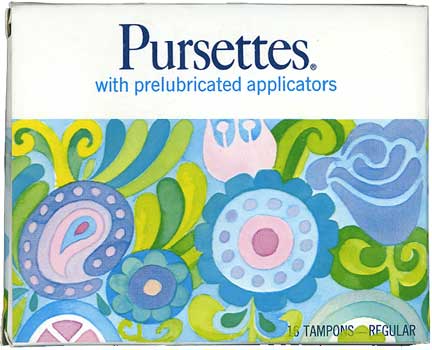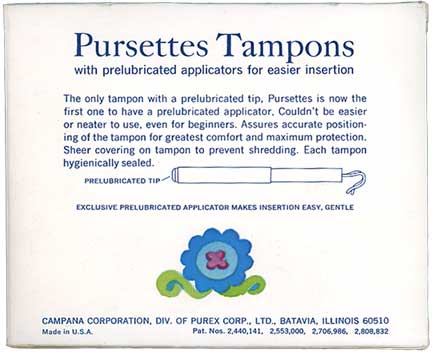See a Pursettes booket for teenagers (late
1950s?).
The Pursettes black
plastic tote
(carrier) with tampons. (An ad sold the tote,
and an enthusiastic customer mentions the
tote in her testimonial.)
Tampax keeps an eye
on its competitor Pursettes:
Tampax tampon inter-office
memo with attached ads, U.S.A., 1964
Want to be a SCHOOLEBRITY
in the know? (Huh, you say?) Read
Are you in the know? BOOKLET collection
of the great
pad & etiquette tips for teens Kotex ran
for decades (but without the ads) (1956)
Booklets
menstrual hygiene companies made for girls,
women and teachers - patent
medicine - a list
of books and articles about menstruation
See early tampons
and a list of tampons
on this site - at least the ones I've
cataloged.


|

The Museum of Menstruation and
Women's Health
Pursettes
lubricated applicator menstrual
tampons, box of 16, 1960-70s?
Campana Corp., Batavia,
Illinois, U.S.A.
Campana seemed to aim
Pursettes (small enough to fit
in a purse) at young users;
the ads
emphasize that (more ads in the
column at
left) for its non-applicator
version. But these
usual-size applicator tampons
take up more room in the purse
and I suspect were not what the
company originally had in mind.
Did it bow
to consumers who wanted
as little contact as possible
with menses and genitals?
But the selling points for this
tampon seemed to be the lubricated
applicator - the company
had to tell users how
to
handle it without its slipping
- and the very
absorbent
plug, the part that stays
in the vagina. We all know that
the late 1970s ushered in the
toxic shock crisis that certain
tampon materials caused. Did Purilon,
the plug material here,
play a part?
Pursettes apparently didn't
survive the 1970s, the decade
Johnson & Johnson bought the
German tampon o.b.,
which also lacked an applicator. Was it because
Americans didn't like to put
their fingers into their
vaginas? Tampax
eliminated that closeness as
explained at length in a German
pamphlet (translated).
Menstrual cups
and sponges
would seem to also have that
problem. European women possibly
had less of a problem with that (o.b.).
The early (1930s?-40s)
no-applicator Dale
tampon (with an ad) also had a
lubricated tip, rare
among menstrual tampons.
I thank
the contributor!
|
Below:
The box
measures 5 1/2 x 4 1/2 x 1 1/8"
(14.3 x 11 1/2 x 2.8 cm).
|
Below:
Compare the box art with sections
of contemporary posters by Peter Max (top,
1968,
"The Different Drummer") and Milton Glaser
(bottom, 1966, included in Bob
Dylan's greatest hits album).
|
 |
|
Below:
The back
of the box. "Prelubricated"
appears five - count 'em, 5 -
times! Pursettes made it their selling point
since its applicator size was no
longer different from other
tampons. It's interesting that the
text doesn't mention the apparently
highly absorbent plug
(the usually cotton or cellulose
part) composed of Purilon. The
user would have to read the
instructions for that information.
High
absorbency would sell a
lot of tampons in the 1970s - Rely, for
example - with tragic
consequences.
|
|
 |
|
Below:
The long
sides are identical.
|
|
 |
|
Below:
But the short
sides
are different.
|
|
 |
|
 |
|
© 2010 Harry Finley. It is illegal to
reproduce or distribute any of the work on
this Web site in any manner or medium
without written permission of the author.
Please report suspected violations to hfinley@mum.org
|